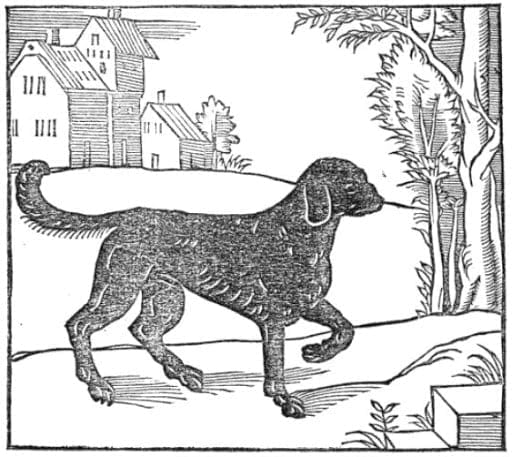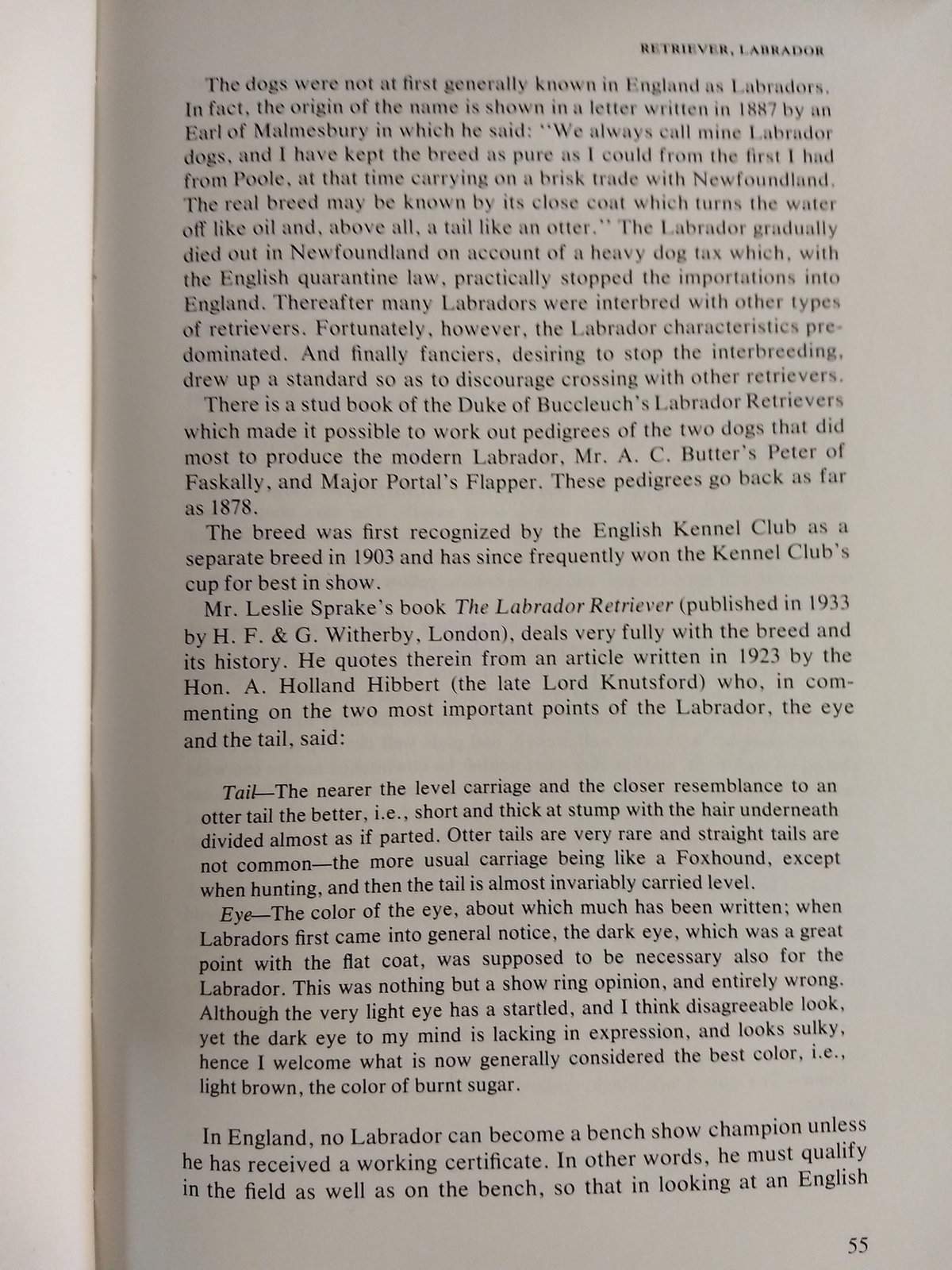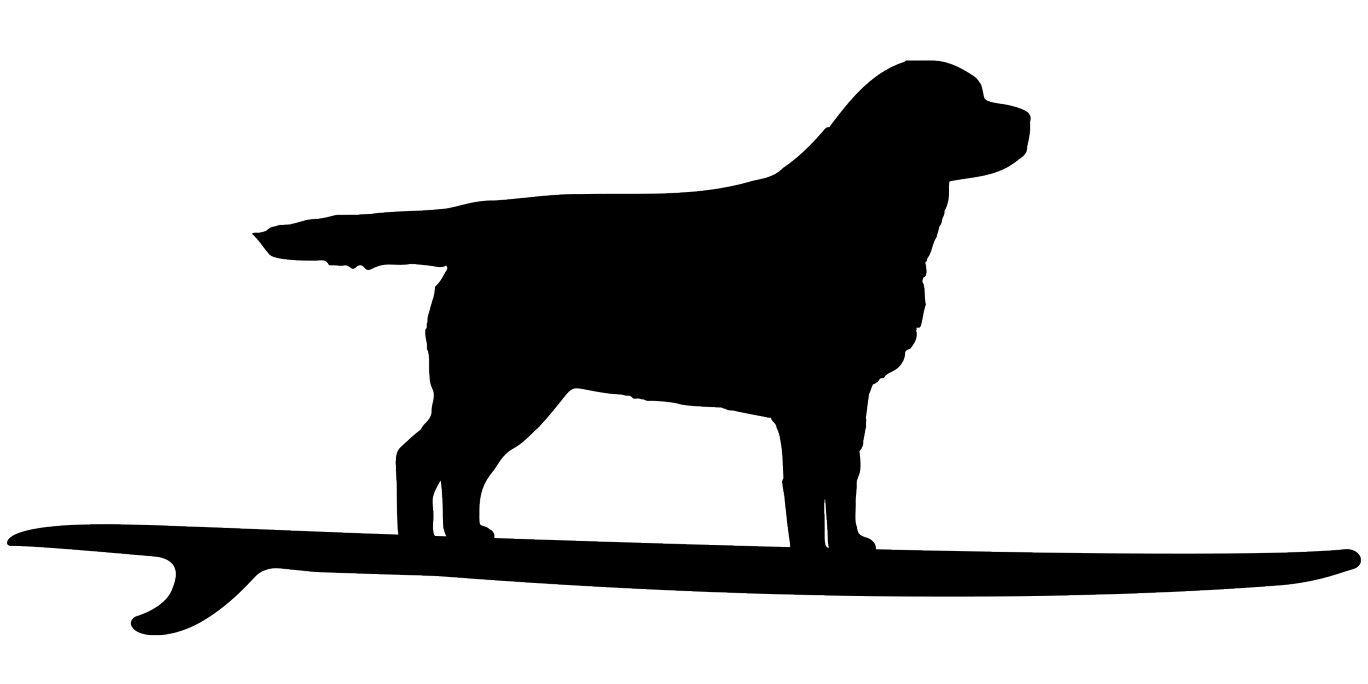The Labrador Retriever didn’t start developing into its current form until about the mid-1880’s in the United Kingdom.
It is a true “Dual Purpose Breed” and should be bred as such – to be a working retriever, on land and in water, and to compete in conformation.
Retrievers in the UK were primarily used on shooting estates, where land-based game birds and lagomorphs were their main quarry. Some were used to retrieve waterfowl, but the British retriever culture was primarily that of a land-based working dog.
Although the Labrador is considered a water dog, (which is in part accurate), its ancestor the SJWD was solely a water dog.
1576
Saint Hubert’s Dog

A book written in 1576, Booke of Hunting, by George Turbervile, discusses various hunting dogs used by the West Country hunters. One of the available dogs was a black dog called a “Saint Hubert’s hound” in honor of the patron saint of the hunter. Although no definitive evidence exists, the available data makes it likely that the St. John’s water dog descended from the St. Hubert’s dog. Other breeds have been posited as potential precursors, the theories have been disproven. What is known is that sometime during the 16th and 17th centuries, it is very likely that the English, including outdoorsman from Devon, imported hunting dogs to Newfoundland. Subsequently, selective breedings of these dogs based on both the environment and the work needed from them led to the St. John’s water dog.

The Coast of Newfoundland was the St. John’s Water Dog’s place of origin. Identified as a landrace, the St. John’s Water Dog (“SJWD”) was a forerunner/ancestor of all retriever breeds, as well as the Newfoundland.
The SJWD and the Labrador are sometimes referred to as one and the same, which is not the case. The Labrador is one of many breeds that descends from the SJWD.
SJWD was heralded for unsurpassed working ability in Newfoundland’s coastal waters. They could swim effortlessly through the frigid Atlantic pulling fishing lines and heavily laden nets back to their masters’ boats. The SJWD was also used for retrieving fish that had fallen from the fishermens’ nets.
Little is known of the types that went into its genetic makeup, although it was probably a random-bred mix of old English, Irish and Portuguese working dogs.
One aspect of retriever history that has been overlooked is that St. John’s water dogs came in both smooth and feathered varieties.
1712
St. John’s Water Dog
1803
Newfoundland Dog

While the Newfoundland dog’s distant ancestry is uncertain, there is consensus over the breed’s more recent predecessor, the St. John’s water dog. In that regard the breed shares some commonality of consanguinity with the Labrador but they are also distinctly different breeds today.

The earliest account of the water dog from Newfoundland being used as a retriever is from Col. Peter Hawker’s Instructions to Young Sportsmen in 1814. Hawker was a celebrated shooter and a veteran of the Napoleonic Wars. He recommended the “true Newfoundland” as the best retriever, which he describes as being “scarcely bigger than a pointer.” He describes the coat as “short or smooth,” a phrase that could mean that some with “smooth coats” were actually long-haired but had no wave to them. Hawker included an image of one of his “Newfoundlands” fetching a flock of Brant geese and swans. The dog’s tail can be seen sticking above the surface of the water.
1814
Newfoundland Retrievers
1822
1st Small Water Dog Reported

The reason why the long-haired dogs became common in England and disappeared from Newfoundland can be found in the writings of William Epps Cormack, the first European to walk across the interior of Newfoundland in 1822.
He wrote of the settlers of Newfoundland using their smaller water dogs to hunt waterfowl and game birds, but they preferred to use the short-haired dogs for this task:
“The dogs here are admirably trained as retrievers in fowling, and are otherwise useful. The smooth or short-haired dog is preferred, because in frosty weather the long-haired kind become encumbered with ice upon coming out of the water.”
Any long-haired puppies that would have been born to the smooth-haired dogs would have been among those they would have exported to Britain, where they would have worked very nicely as working retrievers on shooting estates. In the more mild climate of the British Isles, the long coat would not have been so much of a problem.
Some texts call this dog a “lesser Newfoundland” or “true Newfoundland” to differentiate between this smaller dog and the large Newfoundlands.

Early in the nineteenth century the Earl of Malmesbury imported these “small water dogs” to England.
When SJWD’s were imported in England, they were crossed with a variety of English hunting dogs. Breeding programs were reserved to the landed aristocracy. In due time, breeding programs converged to the point where one breed, the Labrador Retriever, was officially recognized in 1903 by The United Kingdom Kennel Club.
1830
Newfoundland Water Dogs Imported to England
1835
"Labrador" Name Referenced

The 3rd Earl of Malmsbury in a letter written to the 6th Duke of Buccleuch said, “We always call mine Labrador dogs and I have kept the breed as pure as I could from the first I had — the real breed may be known by their having a close coat which turns water off like oil, and, about all, a tail like an otter.” However, all breeders did not always “keep the breed pure”. Many breeders, realizing the excellent qualities, crossed Labradors with other retrievers. Still, if a Labrador is crossed with some other strain, the Labrador type nearly always predominated and their descendants were most always called Labradors.
Read More on the Labrador Club

In 1884, a group of 13 breed clubs, 10 American clubs and three Canadian clubs founded the American Kennel Club.
1884
AKC Formed
1891
Crufts England Dog Show Established

Crufts is named after its founder Charles Cruft. In 1876, a young Charles left college with no desire to join the family jewellery business. Instead he took employment with James Spratt who had set up a new venture in Holborn, London selling ‘dog cakes’.
Charles Cruft was ambitious and a relatively short apprenticeship as an office boy led to a promotion to travelling salesman. This brought him into contact with large estates and sporting kennels. His next career move with Spratts saw him travelling to Europe and here in 1878, French dog breeders, perhaps seeing entrepreneurial talents in Cruft, invited him to organise the promotion of the canine section of the Paris Exhibition. He was still just two years out of college.
Back in England in 1886 he took up the management of the Allied Terrier Club Show at the Royal Aquarium, Westminster. It was in 1891 that the first Cruft’s show was booked into the Royal Agricultural Hall in Islington and it has evolved and grown ever since.

The first documented field trial was held in England in 1899 and consisted mostly of Flat-Coated and Curly Coated retrievers.
Four years later Munden Single became the first Labrador to win a Challenge Certificate (like ‘winning the points’ in an AKC dog show).
Then the following year she became the first Labrador to run in a field trial.
1899
First Field Trial
1903
Royal Kennel Club

Labradors were recognized as a breed by the Royal Kennel Club.
A little known fact, the lion’s share of retrieving for the early Labrador in England was on land. The great shooting estates of the landed aristocracy showcased the early Labrador Retrievers in driven field shoots. The keen marker, the swift and agile dog, were breed traits considered to be of great value.
Much about the early days of our breed was not well-documented. Few records were kept of outcrosses to other breeds. The Duke of Buccleuch, one of the breed’s founding fathers, kept formalized, well-chronicled breeding records, which are still available today for review.

The AKC accepts the Labrador as a registrable breed under its rules.
1917
AKC Recognized as a Breed
1922
Crufts Champion Labradors

King George V (Wolverton) Labrador Retrievers at Crufts 1922.

The first breed standard was a rather spartan document. Its most detailed section concerned movement.
The breed standard assigned by the AKC was put in place before the formation of the Parent Club.
1929
AKC Recognized as a Breed
1931
United Kingdom Field Trial

An example of Cambridgeshire Labrador Retriever Club Trials in the United Kingdom – hunting upland game.

Retrievers in the UK were primarily used on shooting estates, where land-based game birds and lagomorphs were their main quarry. Some were used to retrieve waterfowl, but the British retriever culture was primarily that of a land-based working dog.
1931
Labradors in the UK hunting on land
1931
The Labrador Retriever Club

The Labrador Retriever Club, the AKC Parent Club of the breed, was incorporated. It adopts its own breed standard, which is accepted by the AKC.

1936
Labrador Retriever Club Field Trials
1938
Amateur Owner Wins Field Trial

In the early years in America, field trials were the sport of wealthy families and they were a closed group.
Sometimes trials were held on Mondays so few working people could attend. In 1936 Amateur Open allowed owners to compete.

AKC Labrador Retriever Specialty Show was held in Tuxedo Park, New York.
43 benched Labradors. No record of the field trial.
1939
AKC Labrador Retreiver Specialty Show
1957
1931 Standard is Revised

The subsection on movement was scaled back comparing the ‘31 and ‘57 standards.

The word ‘national’ was added in the 1970s, after AKC created the local “specialty club” program. The national moniker was added to distinguish a national show for Labradors only from a local show for Labradors only.
The Specialty Field Trial and the Specialty Show were originally held together on the same site on Long Island, but passing years saw the separation of the two events because of time and increased entries.
The Labrador Retriever Club of the Potomac-hosted the first “rotating”
National Specialty Show in 1975 at Gaithersburg, Maryland.
1975
First National Specialty
1975
The Last Dual Titled Labrador

The last dual titled Labrador was Dual CH AFC Hiwood Shadow.
He earned his Championship Conformation title AND his Amateur Field Champion title.. the last dog to do so.
With such specific line breeding of conformation bench bred dogs (English to laymen), and field performance dogs (American) it seems we no longer have dogs that can earn the all mighty dual title.

These are the last two of the St. John’s water dogs. They were found in Newfoundland in the late 70’s and were featured in Richard Wolters’s The Labrador Retriever…The People…The History…Revisited. The dogs were two ancient males– 13 and 15 years old. One of them was named “Lassie.” Because they were both dogs, there were no bitches to breed them to.
Labradors today with a permissible white spot on their chest can thank the SJWD.
1980
St. John's Water Dog goes Extinct
1994
Revised Standard

The intended purpose of revising the standard in 1994 was to close the gap and to create a blueprint for a dual purpose Labrador.
It was revised to exclude dogs less than 22 inches at the withers.
Some breeders whose dogs no longer met the standard were part of an $11 million class-action suit against the AKC Labrador Retriever Parent Club which eventually was denied motion for preliminary injunction.

Bench Bred Labradors and Field Performance Labradors have continued to be selectively bred for one purpose – not two.
This had further created a larger and larger divide in the breed amongst, lovers, enthusiasts, historians, and pet owners.
We have some great CH labradors with MH and JH titles, and hopefully it won’t be another 50 years until we see another dual title FC CH.
It is our hope we can one day we can meld these two worlds back into one and have a dual purpose bred performance dog that also wins in the conformation ring.
2000
The Great Divide
2021
America’s Most Popular Dog Breed Dethroned

The Labrador Retriever ranked as the Number 1 most popular dog breed from 1991-2021. Unseated recently by the cute little Frenchie.
Read The AKC Most Popular Dog Breeds

GrChS Grampian Up On The Roof Top SH CGC TKN got his first Master pass at the 2024 LRC Inc National Specialty, so he’s one to keep an eye on for his FC title!
We’re rooting for his trainer/handler Lois Munroe of Heart and Soul Retrievers in NH

